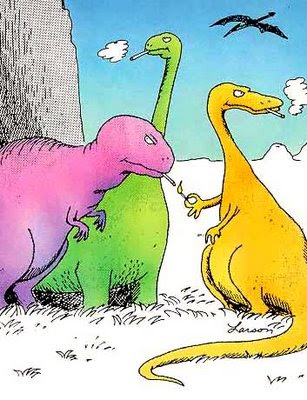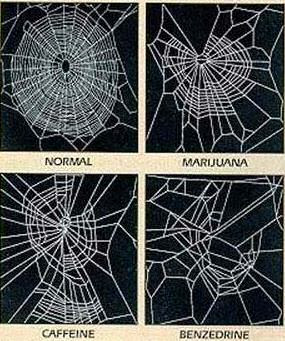David Icke describes the nature of the global situation we are facing and how we can collectively change things for the better. This is no-holds-barred television interview with Ross Hemsworth. Edge Media TV sponsored the provocative broadcast, which was aired over the Internet on the 23rd of October, 2008. Icke predicted the current state of affairs and the debt-centric bank bailout solutions being offered by Obama and other world leaders.
Tuesday, March 31, 2009
What is Reality (and Why)?
Nirvana: nibbana.com

Nibbana (nirvana) an excellent Buddhist resource (English-Burmese) since 1998

- Tipitaka: The Three Divisions of the Buddha's Teachings
- Dhamma discourses by monks
- Dhamma publications by lay persons
Cosmic Enlightenment for All?
The GoldRing is the rotating circle of light sealing spiritual bodies in fields of pure harmonic vibration. Enlightenment continuously combines and connects spiritual beings into absolute oneness.
Higher non-physical ethereal energies given through the power of the galactic central suns manifest the electromagnetic waves and charged bodies of sentient life into physical points of existence. Beings of all levels of manifestation that have polarity, spin and power interweave in relationships to create universal expression.
Channeled Explanation of "Karma"
The Hindus learned about karma from two primary sources. The first was the handed down knowledge of the Vedas. This was given to them by sky beings (Brahmas, Nagas, Yakkhas, Asura, and Akasa Devas or "space deities" who keep what Edgar Cayce in a New Age Christian context called the "Akashic Records"). The second was by direct seeing of rishis (seers). These psychics had the ability to see. But they were subject to bias.
The Buddha warned that without perfect development of one dibbu-cakkhu (divine eye), a seer was likely to misunderstand what had been seen. For instance, if one perceived a very bad person passing away and going to a fortunate rebirth destination, the seer was likely to say that either
- There is no result of karma or
- Bad actions yield good results or
- One's destiny after death is haphazard.
It is the fault and failure of the seer. The error is to extrapolate too broadly from too few cases. The first view is particularly harmful. As a fixed wrong view (miccha-ditthi), it results in a great deal of suffering. The other views have the tendency to mislead beings but are slightly less harmful.
The present seer should therefore be understood on the terms of what is said as it is perceived and understood. What is directly seen is nevertheless focused through the prism of one's understanding. And that is where distortions and interpretations come in. Information can still be useful. It takes a sammasambuddha (a fully-awakened one) to make sense of karma.
The views of this seer are presented only to arouse discussion. Many Westerners may hold the first wrong-view -- that of not believing that there is any result of karma whatsoever. It would be better to mistakenly think that this will lead to that instead of believing that there is no result at all.
The topic of karma is very complex. However, it is explained in modern English in accord with the Buddha's teaching by Pa Auk Sayadaw in The Workings of Kamma. Available for free download at:
Face of Buddhist "Killing Fields" on Trial

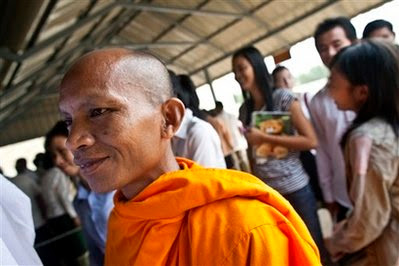
Cambodian Buddhist monk looks on as he and others wait in line outside the Extraordinary Chambers in the Courts of Cambodia on the second day of a UN-backed tribunal, 3/31/09, in Phnom Penh, Cambodia. On the first day of the trial prosecutors alleged the former Khmer Rouge commander oversaw grisly atrocities at the prison (AP/David Longstreath).
Genocidal torturer, born-again Christian Kaing Guek Eav ("Duch" pronounced D'oik), has confessed and asked victims for forgiveness (AFP).
Sex: Who Enjoys It?
Gang of Juvenile Dinosaurs Discovered
A new fossil find suggests that young Triceratops dinosaurs were gregarious gangsters, not solitary types.
- Sex Apes: Humankind's closest relative
- Sex Arrests: Enforcement spurs rise in Web sex arrests
LiveScience.com (3/25/09)
 03.27.09 in Animals by Robert Roy Britt
03.27.09 in Animals by Robert Roy Britt
Boiling Mad: Crabs Feel Pain
Not only do crabs suffer pain, but they retain a memory of it, study finds.
 03.30.09 in Animals by LiveScience Staff
03.30.09 in Animals by LiveScience StaffWhy Chimps Are Stronger Than Humans
We pay a price for our fine motor skills.
Monday, March 30, 2009
Buddhist Genocide: Khmer Rouge



Tourists visit the Choeung Ek Genocidal Centre built on the site of Cambodia's infamous "Killing Fields." The Khmer Rouge regime's prison chief has finally stood trial for atrocities. The newly born again Christian is accused of overseeing the torture and execution of 15,000 Buddhists three decades ago (AFP/file/Voishmel).
Disabled survivors of the regime joined earnest young law students and other spectators in a modern custom-built courtroom on the outskirts of the Phnom Penh to watch the long-delayed proceedings get under way. More>>
Buddha's 32 Marks of a Great Man

- See related article: Sexy People Sound Better
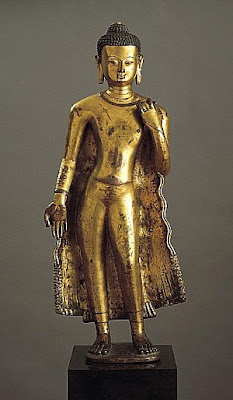 The amalgam of Eastern philosophy from India is now called "Hinduism," although there was never any such term in India, nor was there the idea of a "religion" separate from life. There were various dharmas (schools of thought). But almost all were centered around traditions handed down in the great epics, Aryan writings, and great commentaries.
The amalgam of Eastern philosophy from India is now called "Hinduism," although there was never any such term in India, nor was there the idea of a "religion" separate from life. There were various dharmas (schools of thought). But almost all were centered around traditions handed down in the great epics, Aryan writings, and great commentaries. - Well-supported feet. Firm undertaking
- Wheels beneath the soles of the feet. Great retinues
- Projecting heels. Long life
- Long fingers and toes. Long life
- Soft and tender hands and feet. Well-united with people
- Net-like hands and feet. Well-united with people
- Ankles raised like conch shells. Becomes the best
- Lower part of the leg is like an antelope's. Gets the best things quickly
- Can touch and rub around his knees with both palms, while standing without bending.
Great wealth - The part concealed by garments is covered by a hood. Many sons
- Skin shines like gold. Get finest furnishings and garments
- Subtle skin such that dirt and sweat do not adhere to body. Great wisdom
- Single hairs, one to each pore. Well-respected
- Hair pointing upwards, black, ungraying, turning in rings to the right. Becomes the best
- Body frame is straight like Brahma ("supreme one"). Long life
- Seven outflows on his hands, feet, at the tips of the shoulders, and at the top of the back.
Obtains excellent foods - Upper part of the body is lion-like. No loss
- The hollow between his shoulders is filled. No loss
- Proportional with a body as long as the span of the arms. Great wealth
- Shoulders evenly rounded. No loss
- Releases the highest of tastes. Very healthy
- Jaw is lion-like. He cannot be overthrown.
- Forty teeth. His assemblies cannot be divided.
- Teeth are even. Pure retinues
- Teeth are undivided. His assemblies cannot be divided.
- Visible teeth are very white. Pure retinues
- A long and mighty tongue. His words are heeded.
- The voice of Brahma, mellifluous, resembling the song of a karavika bird. His words are heeded.
- Very blue eyes. Attractive look
- Eyelashes like those of a cow. Attractive look
- The filament between the eyebrows is white like soft cotton. Well-respected
- Head is turban-crowned. Many followers
- See also at web.ukonline.co.uk/buddhism/32marks2.htm
- PHOTOS: Bas relief, Asian collection, Norton Simon Museum, Buddha Shakyamuni
Conficker: Vast Computer Spy Network
 In a report provided to the newspaper, a team from the Munk Center for International Studies in Toronto said at least 1,295 computers in 103 countries had been breached in less than two years by the spy system, which it dubbed GhostNet.
In a report provided to the newspaper, a team from the Munk Center for International Studies in Toronto said at least 1,295 computers in 103 countries had been breached in less than two years by the spy system, which it dubbed GhostNet.Embassies, foreign ministries, government offices and the Dalai Lama's Tibetan exile centers in India, Brussels, London, and New York were among those infiltrated, said the researchers, who have detected computer espionage in the past. More>>
- Free patch (and removal tool) at www.Symantec.com
- If you can't log on to Symantec.com, you're infected.
- Contact your ISP or Internet security provider.
Sunday, March 29, 2009
Cyber-spying Ring targets Dalai Lama
 Massive cyber-spying ring
Massive cyber-spying ringA vast electronic spying system has hit government and private computers in 103 countries.
Saturday, March 28, 2009
Some visit Pol Pot's grave looking for luck
 ANLONG VENG, Cambodia – He was one of the greatest mass killers of the 20th century, but that doesn't stop the hopeful from praying at Pol Pot's hillside grave for lucky lottery numbers, job promotions, and beautiful brides.
ANLONG VENG, Cambodia – He was one of the greatest mass killers of the 20th century, but that doesn't stop the hopeful from praying at Pol Pot's hillside grave for lucky lottery numbers, job promotions, and beautiful brides.Nor does it stop tourists from picking clean the bones and ashes from the Khmer Rouge leader's burial ground in this remote town in northwestern Cambodia.
Court considers trying former US officials
 MADRID, Spain – A Spanish court has agreed to consider opening a criminal case against six former Bush administration officials, including former Attorney General Alberto Gonzales, over allegations they gave legal cover for torture at Guantanamo Bay, a lawyer in the case said Saturday.
MADRID, Spain – A Spanish court has agreed to consider opening a criminal case against six former Bush administration officials, including former Attorney General Alberto Gonzales, over allegations they gave legal cover for torture at Guantanamo Bay, a lawyer in the case said Saturday.Human rights lawyers brought the case before leading anti-terror judge Baltasar Garzon, who agreed to send it on to prosecutors to decide whether it had merit, Gonzalo Boye, one of the lawyers who brought the charges, told The Associated Press.
Madonna to Adopt 2nd African Baby
 MALAWI, Africa – Madonna is expected to arrive in Malawi Sunday, airport officials said, as the star's plans to adopt a girl as her second child from the poor African country began to draw criticism.
MALAWI, Africa – Madonna is expected to arrive in Malawi Sunday, airport officials said, as the star's plans to adopt a girl as her second child from the poor African country began to draw criticism.The luxury lodge where Madonna has stayed in the past has been fully booked and casual visitors have been turned away. International media have begun arriving in the capital in anticipation of her visit. More>>
- VIDEO: Madonna to Adopt Again? (ABC News)
Buddhist Dream Interpretation
- 10 Amazing Facts About Dreams (ListVerse)
When Buddhists in India dreamed they dealt with their dreams in a variety of ways. Certain types of dreams occurred frequently enough to the ancients to merit listing as separate categories for dream-analysis. The categories show the following different kinds of dreams. The most distinctive use, for Buddhists, was
- seeing dreams as a simile for emptiness, sunyata, the ultimate nature of all things.
- seeing dreams as portents of things to come, which overlapped with another type of dream:
- as messages or teaching by the gods, spirits, or bodhisattva.
- Buddhists in India and in China thought, like Freud and Jung, that it was possible to diagnose aspects of the dreamer’s mental and physical health from the symbols of dreams.
- The theoretical psychology school of Buddhism, the Vijnanavada (“Consciousness-only”) School, called dreams “monkey-sleep,” a function of the “isolated mind-consciousness”.
- Buddhist psychologists saw dreams as the return at night of things thought on during the day.
- Finally, Nagarjuna explained dreams as a standard for testing the quality of a bodhisattva’s vows.
1. Dreams as a simile for emptiness.
The most common use of dreams in the literature of the Mahayana -- or “Northern School” of Buddhism in China, Tibet, Japan, Korea, and Vietnam -- is to see dreams as a simile for sunyata, (emptiness) the hollow core at the heart of all component dharmas (things). For example, in the well-known Vajra Sutra (Diamond Discourse), the Buddha taught that:
“All conditioned dharmas, are like a dream, like an illusion, like a bubble, like a shadow, like a dewdrop, like a lightening flash; you should contemplate them thus.”
Dreams symbolize the changing and impermanent nature of all things known to the senses. Sights, sounds, smells, flavors, sensations of touch and thoughts are all dream-like, fleeting, and ultimately unobtainable. By pursuing and grasping material things or ephemeral states, we create the causes for misery and suffering. Those desire-objects are not real and permanent.
Bubbles burst, shadows run from light, dewdrops vanish by noon without a trace, lightning roars and vanishes, and dreams leave us at dawn. To continually perceive such things as real locks us into the endless cycle of birth and death. The Buddha was not simply giving us an evocative metaphor, a literary device or a philosophical point. He felt related to all beings, and in his compassion he was pointing out to his family a way to escape the prolonged misery of affliction and death. The dream simile occurs over and over in the sutras to teach about emptiness.
In the Ta Chih Tu Lun, dreams occur as a didactic teaching device. Sariputra, the foremost Arhat [enlightened disciple] in wisdom, learns the true application of the emptiness theory through the simile of dreams. Dreams are like ordinary waking reality in that both are empty and false. There is nothing gained by seeking out or clinging to any thought or mark that distinguishes the two states.
With the exception of message-dreams and portent dreams, two categories that we will look at below, for the Buddha’s monastic disciples who were intent on cultivating the mind full-time, dreams were considered as illusory and false, no different from the illusions of waking-time reality.
2. Message-dreams or teaching by the gods, spirits, or bodhisattvas
Dreams can be a message from a bodhisattva, an ancestor, a god, or a spirit [brahma or deva]. The intent of the dream may be to test the dreamer’s resolve: Is one non-retreating (avaivartika) from Bodhi (enlightenment) even when sleeping? The purpose of the dream visit may be to communicate information vital to the dreamer’s well-being.
3. Prescient or Portent Dreams
Prescient or portent dreams that predict the future are the only category of dreams that the ancients considered real or valuable in itself. Based on the records we have, it seems that dreamers in the past wanted to know more or less what dreamers want to know now: whether their dream augured good luck or misfortune. The office of dream diviner was esteemed, and nobility and commoner alike, waking after a dreamy sleep, sought to know the meaning of their dreams. More>>
UK Protests Economy Today
GET ACTIVE
SURFING for Buddha pictures? Clicking on slideshows? Googling for an ego boost? Caught red handed, fingerprints on the keyboard! Do good via the Internet. Here's a mission for a curious mouse.
FACEBOOK fanatics can help spread the word about worthy causes by posting a widget through the Facebook Causes application (apps.facebook.com/causes). There are philanthropic passions a plenty! Create one or choose from efforts like "Stop Global Warming" and "No Mc-Donald's in Cusco."
Antarctica to Pyramids — lights dim for Earth
Sexy People Sound Better
His own explanation of this (the 32 major and 80 minor physical marks of greatness) was karmic. Sutras explain how he came to have each feature, from his bright golden complexion to his blue eyes, from jet black curly hair to his sonorous voice. His voice in particular inspired confidence. It could be heard at a distance in a time when there were no microphones or PA systems.
Greg Soltis (LiveScience.com)
People with voices deemed sexy and attractive tend to have greater body symmetry upon close inspection, suggesting that what we hear in a person can greatly affect what we see in them.
 "The sound of a person's voice reveals a considerable amount of biological information," said Susan Hughes, an evolutionary psychologist from Albright College in Reading, Pa. "It can reflect the mate value of a person."
"The sound of a person's voice reveals a considerable amount of biological information," said Susan Hughes, an evolutionary psychologist from Albright College in Reading, Pa. "It can reflect the mate value of a person." Hughes, whose new study is detailed in the June 2008 edition of the Journal of Nonverbal Behavior, cautions that an attractive voice does not necessarily indicate that this person has an attractive face.
A symmetric body is genetically sound, scientists say, and in evolutionary terms, in the wild, it can be an important factor when selecting a mate. But sometimes changes during prenatal development can slightly skew this balance. For instance, the length ratio between index and ring fingers, known as the digit ratio, is fixed by the first trimester, a time that corresponds with vocal cord and larynx development. If the hormone surge that affects vocal development also affects finger growth, there should be a connection between an individual's voice and digit ratio.
 Hughes could not demonstrate a connection between voice attractiveness and digit ratio in her previous work, possibly due to vocal changes that occur during puberty. So in the new study, about 100 individuals listened to previously recorded voices and independently rated them on nine traits important during mate selection: approachability, dominance, healthiness, honesty, intelligence, likelihood to get dates, maturity, sexiness, and warmth.
Hughes could not demonstrate a connection between voice attractiveness and digit ratio in her previous work, possibly due to vocal changes that occur during puberty. So in the new study, about 100 individuals listened to previously recorded voices and independently rated them on nine traits important during mate selection: approachability, dominance, healthiness, honesty, intelligence, likelihood to get dates, maturity, sexiness, and warmth. Study participants generally agreed on what made a voice attractive. But when Hughes used a spectrogram to analyze these voice ratings according to different acoustic properties such as pitch, intensity, jitter and shimmer, she could not find a common feature that made these voices seem attractive.
This indicates our perceptual system may be more advanced than expected.
"We can agree on what's an attractive voice yet I can't capture it with a computer," Hughes told LiveScience.
Investigating if a combination of these properties can define an attractive voice may shed light on a connection, she said.
- Original Story: Sexy People Sound Better
Celebrating "Earth Hour"; Mourning Tibet

- First major city to mark Earth Hour 2009 (AP)
- SLIDESHOW: Earth Hour
- VIDEO: World cities begin big switch-off (BBC)
Meanwhile, with an enormous propaganda campaign celebrat-ing "Serf's Emancipation Day," the totalitarian state of the People's Republic of China is marking a minor holocaust.
- China marks 50 years of direct control over Tibet (AP)
- SLIDESHOW: Tibet
- VIDEO: China marks 50 years of Tibet rule (AP)
- VIDEO: AP Top Stories (AP)
Friday, March 27, 2009
Jailed Burmese Monk on Hunger Strike
VOA News (1/23/09)
The sister of a Buddhist monk imprisoned by Burma's military rulers for pro-democracy activities says her brother is on a hunger strike.
Khin Thu Htay tells VOA Burmese service that monk Ashin Gambira began the hunger strike 10 days ago after prison authorities blocked him from seeing her and other family members. She says the family tried to visit him at a prison in the central region of Mandalay.
The sister says Burmese authorities told her that several days later, Gambira was transferred to another prison Hkamti in a remote part of the northwestern Sagaing region.
Courts in military-run Burma sentenced the monk last year to 68 years in prison for leading pro-democracy protests in 2007. More>>
- Ven. Ashin Gambira (scoop.co.nz)
"Crush the Dalai Lama" -- China
VOA News (2/19/09)
Chinese authorities in Tibet are calling on officials, security forces, and the general public to "crush" any signs of support for the Dalai Lama.
In a report Thursday in China's state-run Tibet Daily newspaper, the local government vowed to fight what it calls the "savage attacks" of supporters of the exiled spiritual leader.
China accuses the Dalai Lama of seeking independence for Tibet and provoking mass protests against Chinese rule last year. Authorities have tightened security in Tibetan regions of China ahead of the March 10 anniversary of the start of the protests. More>>
Fighting Back: Traffic Cameras
 Traffic cameras spark rage
Traffic cameras spark rageAngry motorists are fighting back over the increasing number of intersection cams.
- Unusual methods (WSJ.com)
Hallucinogen for Churchgoers

"How to Prepare Ayahuasca" is a film by NeuroSoup.com (music by Loop Guru). The makers of this film are not recommending that people take controlled substances. However, they are suggesting that we all empower ourselves with knowledge.
- Syrian Rue (common Esphand)
- List of legal entheogen suppliers: neurosoup.com/buy_legal_entheogens/
Drugs to Enlightenment?
- Reaction: Supreme Court rules Church can serve Hallucinogen (ABC News)
 It is not clear if entheogens would be barred. Do they occasion heedlessness with regard to the Five Precepts? That is, when one is utilizing a "mind expanding" substance, is one engaging in unskilful behavior one would regret and not otherwise engage in?
It is not clear if entheogens would be barred. Do they occasion heedlessness with regard to the Five Precepts? That is, when one is utilizing a "mind expanding" substance, is one engaging in unskilful behavior one would regret and not otherwise engage in?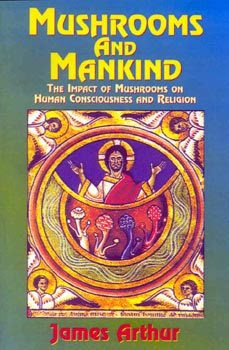 There is no doubt that such groups existed in Hindu, Christian, and indigenous or Native European circles. The most popular entheogen in this regard, as has been reported in WQ, seems to have been Amanita muscaria (Fly agaric mushroom).
There is no doubt that such groups existed in Hindu, Christian, and indigenous or Native European circles. The most popular entheogen in this regard, as has been reported in WQ, seems to have been Amanita muscaria (Fly agaric mushroom). - ignorance (avijja, avidya)
- wrong-views (miccha-ditthi)
- delusion (moha)
- selfishness (lobha, the most common and harmful wrong-view)
- anger (dosa)
- suffering (dukkha), and
- continued rebirth (Samsara).
Does a drug/entheogen/plant lead to liberation from these?
Enlightenment comes in definite stages. And one may have many insights without being the least bit closer to enlightenment.
 The Three Marks (instability, distress, and impersonality) are tricky concepts even for the most sober individual. Failing to understand these fundamental principles, drugs of any kind are likely to worsen one's understanding. They are then likely to lead one on a downward spiral, particularly as one becomes attached to feelings and experiences in spite of one's deteriorating condition. Look at all the addicts around us (coffee, heroin, nicotine, worry, alcohol, synthetic medications). Insight into impermanence, misery and no-self is accomplished systematically:
The Three Marks (instability, distress, and impersonality) are tricky concepts even for the most sober individual. Failing to understand these fundamental principles, drugs of any kind are likely to worsen one's understanding. They are then likely to lead one on a downward spiral, particularly as one becomes attached to feelings and experiences in spite of one's deteriorating condition. Look at all the addicts around us (coffee, heroin, nicotine, worry, alcohol, synthetic medications). Insight into impermanence, misery and no-self is accomplished systematically: There is a famous saying. "Knowledge always leads to pride, whereas wisdom always leads to humility." That's the difference to look for in terms of whether one is progressing on a fruitful path of practice (drugged or otherwise).
There is a famous saying. "Knowledge always leads to pride, whereas wisdom always leads to humility." That's the difference to look for in terms of whether one is progressing on a fruitful path of practice (drugged or otherwise).Thai ex-PM adds to calls for gov't to resign

Supporters of fugitive former premier Thaksin Shinawatra and riot police outside Government House in Bangkok. Thailand's prime minister refused Friday to bow to thousands of anti-government protesters surrounding his offices for a second day running to demand his resignation (AFP/Nicolas Asfouri).
Thaksin spoke via video link from self-imposed exile, his image broadcast on a giant screen outside Government House, which he occupied for six years until he was ousted in a 2006 coup.An estimated 30,000 ringed the compound Thursday evening, but police said their numbers had dwindled to just several thousand on Friday. More>>
Pimp This Bum
But thanks to an Internet marketing campaign and unlikely allies, Edwards has become the human face of homelessness to online viewers drawn to the site by a deliberately controversial name: Pimp This Bum.

